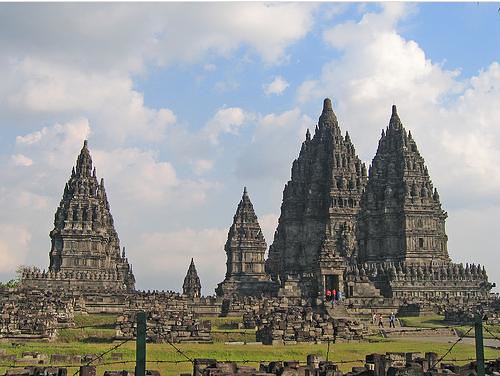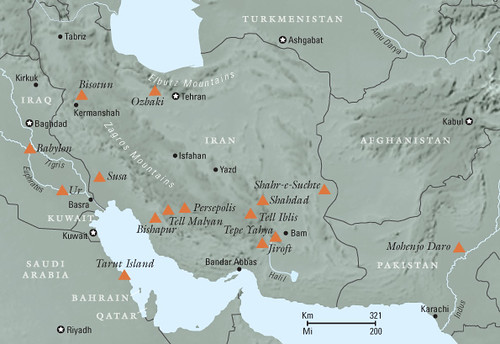Read Part 1
The final pieces of the puzzle is the location of Mount Sinai, the place where Moses received the Ten Commandments. Currently it is believed to be in Saint Catherine’s Monastery in Mount Sinai. In the novel, The Last Cato, we saw the protagonists going there to retrieve some ancient parchments. According to Simcha Jacobovici, this place does not fit a single Biblical criteria and is not in any flock grazing distance. Then he identifies it as Gebel Hashem el-Tarif in Egypt because it has a cleft from which Moses could have preached, has the graves of holy men and there is a fresh water spring at the top, a rare thing in Sinai.
According to the Bible, Moses placed the ten commandments in a golden box called the Ark of the Covenant (the same artifact that Nazis and Indiana Jones fight over in The Raiders of the Lost Ark). In the tombs in Mycenae, Simcha Jacobovici finds an image of the Ark of the Covenant carved in gold. The documentary concludes that with all this evidence it is now sure that the Exodus is a historical fact.
This is documentary is filled with stunning graphics which I have not seen in any documentary, except maybe Brian Greene’s The Elegant Universe. The animations and the visuals are an absolute delight to watch, but still it could not convince Hershel Shanks, the editor of Biblical Archaeological Society.
On the things I know a little about, I tend to disagree with you. Beginning with the Hyksos. This is an old idea. It’s hard to find a scholar today who subscribes to it. Among its many problems: Where were the Israelites for 300 years [from 1500 to 1200 BCE] after the Egyptian expulsion of the Hyksos/Israelites? (Incidentally, you’re not really changing Egyptian chronology, despite what you say. What you are doing is simply dating the Exodus to 1500 BCE.)
Or take the Semitic inscriptions at Serabit el-Khadem. You use a conjectural translation [“God, save me”] of [William Foxwell] Albright. This decipherment is really not secure. Kyle McCarter thinks he has accurately deciphered this writing. He has not yet published it. But everyone knows that Albright’s efforts are uncertain. But even if correct, “El” is not necessarily the Israelite God. It is the generic word for “God.” Many Semites used it. Everyone accepts the idea that Semites were worker/slaves(?) at Serabit. But you jump to the conclusion that they were Israelites—in the 16th century BCE.
Or take your identification of “Jacob.” This name appears fairly frequently at this time. But that doesn’t mean it refers to the Biblical Jacob. The appearance of the name is appropriately used to give a plausibility to the story, but not to say this is Joseph’s father. [The Exodus Debated]
The first historical reference to the Israelites date from 1207 BCE, which is a date much after the demise of the Harappan Civilization in India (to give a time reference). According to Ronald Hendel of the University of California, Berkeley, if the Exodus represents the expulsion of the Hyksos, then they would have been roaming in the desert for about 300 years, which is the same point Hershel Shanks makes. The entire documentary stands on the basis of this date of 1500 BCE, the time of the Santorini eruption. Also it seems the parallels between the Ahmose Stele and the biblical story of the ten plagues are not that identical.
In his defence Simcha writes that the basis of the date of 1207 BCE for first reference to the Israelites comes from the Merneptah stele which records Pharaoh Merneptah’s battles with the Israelites. If the Israelites were strong enough for the Pharoah to brag about it, then they would have been a strong force in 1207 and this can happen only in a time period of about 2-300 years after the Exodus.
The interesting part in this whole debate is the assumption that the Biblical text is a perfect historical document and all the details mentioned actually happened as told. Hershel questions this very basis.
You, on the other hand, start out with the assumption that your Bible is historically accurate, including the miracles, unless you can find some archaeological problem with doing so; and also accepting as proof anything archaeological that seems to confirm the historicity of the text, including the miracles.
You may deny this, but you do do it. As a kind of test, let me ask you if you would apply the same presumption of historicity to other ancient texts, such as Homer and Gilgamesh? Would you accept all the details in Homer as historically accurate, even the miracles and the acts of the gods? Do you accept as a historical fact that the wildman Gilgamesh was acculturated by a prostitute? How about his refusal of a marriage proposal by Ishtar, the goddess of Uruk? Do you believe that Utnapishtim is immortal (as the text says), perhaps still living in disguise somewhere in war-torn Baghdad?[The Exodus Debated]
The response for this from Simcha is that the Torah has been transmitted for over 2700 years without any errors, which makes it very credible. If during Sabbath Torah reading, a single letter is found smudged, the Torah is declared un-Kosher and removed. He says that no other text has such disciplined chain of transmission.
Probably Simcha has never heard of the Vedas which were transmitted exactly the same way. The largest surviving body of ancient literature has been passed down orally for over thousands of years. This Vedic lore, considered to be divine revelation was painstakingly memorized and even when the original meaning of the words were lost, the brahmins remembered and recited the hymns with the utmost fidelity[2]. Will scholars then give the same historical validity to the Vedas which they give the Torah and the Bible?
See Also: Exodus Decoded, Virtual Museum which shows all the evidence, Transcript of the program

